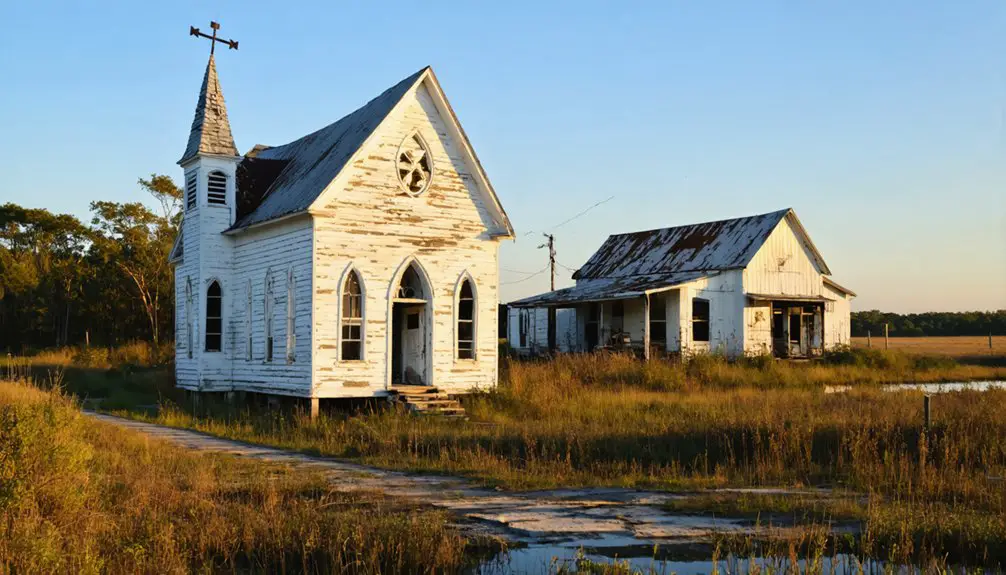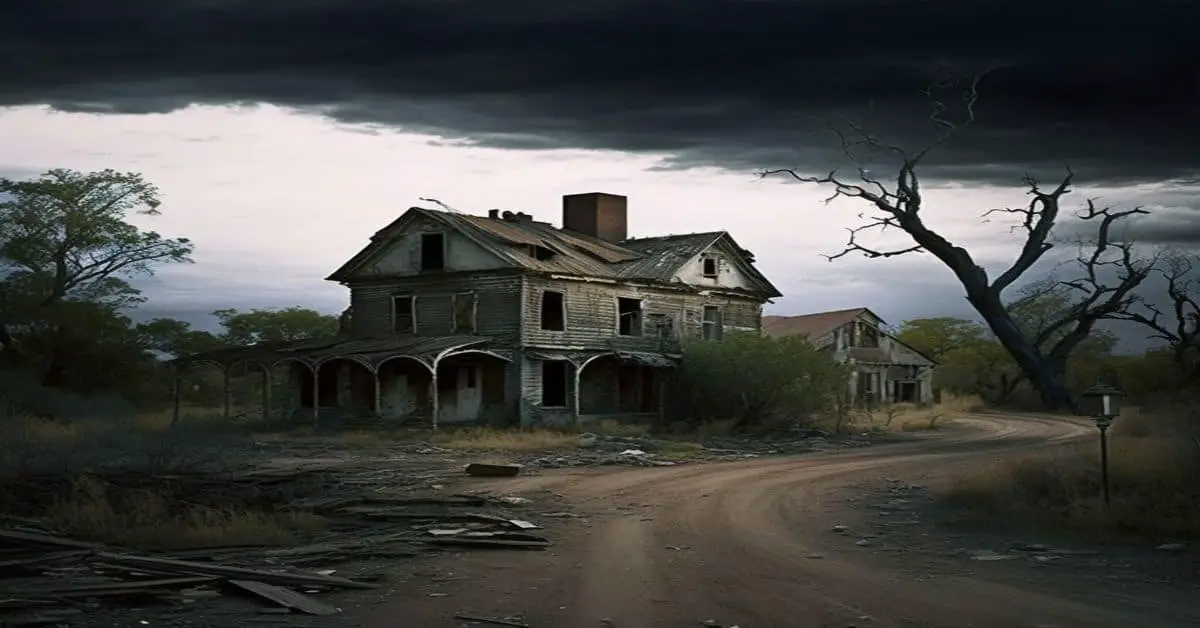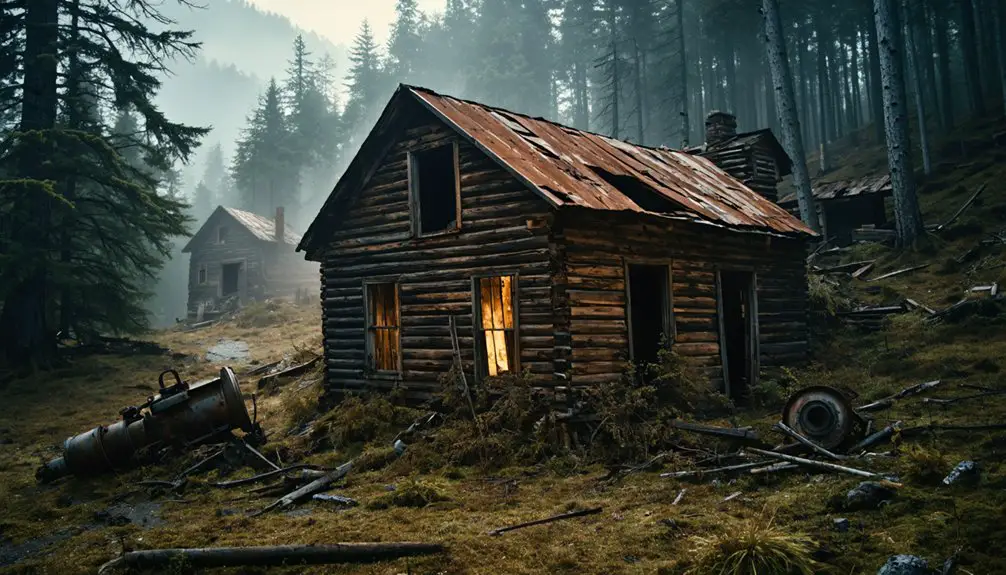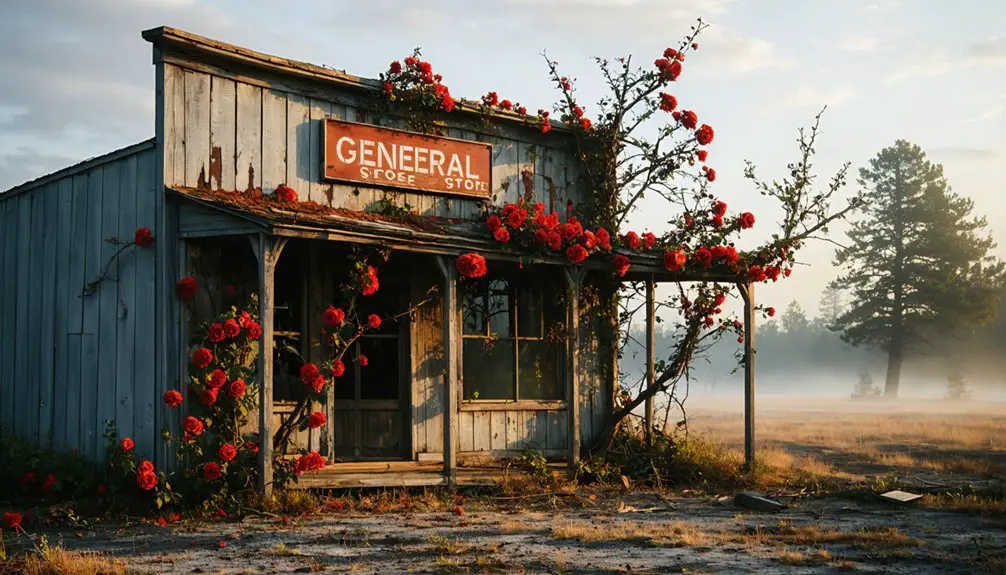You’ll find Marion Station, Maryland’s former “Strawberry Capital of the World,” as a stark reminder of how railroad-driven agricultural prosperity can fade into near-abandonment. Once bustling with hundreds of ice-refrigerated rail cars shipping strawberries nationwide, this Somerset County town now stands largely deserted. While 1,619 residents maintain a stable community today, abandoned buildings and weathered industrial facilities tell the fascinating story of Marion’s remarkable rise and transformation.
Key Takeaways
- Marion Station transformed from “Strawberry Capital of the World” to near ghost town status after its agricultural industry declined.
- Population has decreased to approximately one-fifth of its former size, leaving numerous abandoned buildings throughout the town.
- Historic industrial facilities and homes stand deteriorating, while nature gradually reclaims many abandoned sites.
- Despite ghost town characteristics, Marion Station maintains 1,619 residents with a median household income of $85,577.
- The abandoned Pennsylvania Railroad infrastructure and empty agricultural facilities serve as remnants of the town’s prosperous past.
The Rise and Fall of Maryland’s Strawberry Capital
While many might associate Maryland’s Eastern Shore with blue crabs and oysters, Marion Station once held the impressive title of “Strawberry Capital of the World.” The town’s meteoric rise began with the Pennsylvania Railroad’s arrival in 1866, which transformed this small farming community into a bustling agricultural hub. Today, these historical materials are digitally preserved through various cultural heritage institutions.
You’ll find Marion’s strawberry heritage deeply rooted in the Fragaria x ananassa breed, which revolutionized local farming. Hundreds of ice-refrigerated rail cars shipped berries nationwide daily, while farmers’ wagons lined up for miles at the auction block. The town’s success even led to the construction of the first county hospital in Somerset.
But agricultural sustainability suffered as continuous cultivation depleted the soil. By the 1930s, “strawberried” land and the Great Depression dealt devastating blows. The industry’s decline accelerated when rail service ended in 1976, forever changing Marion’s landscape from strawberry fields to modern crops like soybeans and corn.
Railroad Legacy and Economic Transformation
After the Pennsylvania Railroad’s arrival in 1866, Marion’s transformation hinged on the strategic development of its rail network, particularly through the Newark & Marion Railroad’s establishment in 1900.
You’ll find the railroad’s history deeply woven into Marion’s economic prosperity, with the line handling an impressive 875 cars of celery, 200 cars of carrots, and vast quantities of other produce by 1930. Marion’s status as the largest strawberry producer in the world helped establish its reputation as an agricultural powerhouse.
The economic shifts became apparent as Pennsylvania Railroad’s $140,000 purchase in 1930 brought increased freight capacity and infrastructure investments. The railway maintained three round trips daily for passenger service between Marion and Newark.
The Pennsylvania Railroad’s strategic investment transformed Marion’s infrastructure, marking a pivotal shift in the region’s economic trajectory.
Yet, you can trace Marion’s decline through the changing agricultural landscape – from strawberry shipping hub to poultry farming center.
Abandoned Buildings and Historic Landmarks
Today you’ll find Marion’s abandoned buildings standing as silent witnesses to its once-thriving past, with structures ranging from deteriorating homes to weathered industrial facilities scattered across the landscape.
These abandoned structures serve as physical markers of the town’s economic transformation, each telling its own story of decline and desertion. Similar to many Maryland ghost towns, Marion’s population has dwindled to one-fifth or less of its former size.
Among the historic landmarks, you’ll discover old mills and factories that showcase the industrial heritage that once powered Marion’s economy. The decline mirrors the pattern of many towns where natural resource depletion led to economic collapse.
Local cemeteries and remnants of community centers reveal the social fabric of former residents, while architectural styles of surviving buildings reflect the cultural preferences of their time.
Nature has begun to reclaim many of these sites, creating a haunting blend of structural decay and wild growth that draws photographers and history enthusiasts alike.
Life in Modern-Day Marion Station
Despite its ghost town reputation, Marion Station maintains a modest population of 1,619 residents who’ve adapted to life in this historic Somerset County community.
Marion Station defies its ghostly image, thriving as a small but resilient community of 1,619 souls in historic Somerset County.
The local culture reflects a blend of rural charm and modern resilience, with community dynamics shaped by its demographics and economic realities. The town’s unique character is evident in its low population density of just 30 people per square mile. Health insurance coverage is remarkably comprehensive, with 98.43% insured residents.
- You’ll find a mix of lifestyles here, where the median household income of $85,577 supports a relatively comfortable standard of living, with only 5% of residents facing poverty.
- The community skews older, with a median age around 49 years.
- Property values remain accessible at $179,200 for median homes, attracting both established families and newcomers.
- Your neighbors are likely to be employed (51.74% of residents work), contributing to a stable community where households average 2.6 to 3 people.
Preservation Challenges and Future Prospects
While Marion Station maintains a modest present-day population, the town faces significant preservation hurdles that will shape its future identity.
Maryland’s state government offers preservation tax credits that could potentially aid Marion’s historic rehabilitation efforts.
You’ll find that limited historical records and mounting development pressures threaten the town’s architectural heritage, while the lack of applicable tax credits for non-income-producing properties complicates funding strategies.
Community engagement has emerged as a critical factor in Marion’s preservation efforts. Similar to the challenges faced by local historical societies, genealogical researchers struggle to locate vital records without a central town hall repository.
You can see this through local initiatives focusing on public awareness and fundraising campaigns to bridge financial gaps.
Despite infrastructure challenges, there’s potential in developing heritage tourism and implementing innovative preservation methods.
The key lies in balancing historic preservation with modern needs through collaborative development, while working within the constraints of existing regulatory frameworks that often provide insufficient protection for ghost town properties.
Frequently Asked Questions
Are There Any Documented Paranormal Activities in Marion’s Abandoned Buildings?
You’ll find limited official documentation of ghost sightings or eerie noises in Marion’s abandoned buildings, though local folklore suggests paranormal activity. Most stories remain unverified yet persist through generations of residents.
What Happened to the Original Residents When Marion Began Declining?
Like the Johnson family who moved to Baltimore in ’52, most original residents left during the population decline, seeking better jobs in urban areas or nearby Somerset County’s thriving communities.
Does Marion Station Have Any Annual Events or Community Gatherings?
You’ll find limited annual celebrations in Marion Station today, though the Lions Club occasionally hosts community activities like chicken BBQs. Most traditional gatherings have declined along with the town’s population.
Were There Any Notable Crimes or Incidents During Marion’s Peak Years?
You’ll find limited records of criminal history in Marion Station’s heyday, despite hundreds of daily visitors during strawberry season. Beyond typical small-town incidents, no notable criminal activity stands out in historical documents.
Can Visitors Legally Explore and Photograph Marion’s Abandoned Structures Today?
You can’t legally explore Marion’s structures without proper exploration permits. There’s no available information about specific photography guidelines, and entering without permission would constitute trespassing under Maryland law.
References
- https://en.wikipedia.org/wiki/List_of_ghost_towns_in_Maryland
- https://www.geotab.com/ghost-towns/
- https://kids.kiddle.co/List_of_ghost_towns_in_Maryland
- https://rsftripreporter.net/a-biplane-dive-bombing-a-baptist-church-yep/
- https://en.wikipedia.org/wiki/Marion_Station
- https://preservationmaryland.org/marylands-strawberry-legacy/
- https://collections.digitalmaryland.org/digital/collection/sovf/id/11044/
- https://www.secretsoftheeasternshore.com/classic-strawberry-boom/
- https://thefrogandpenguinn.blogspot.com/2010/06/strawberry-capital-marion-md.html
- https://www.abandonedrails.com/newark-and-marion-railroad



